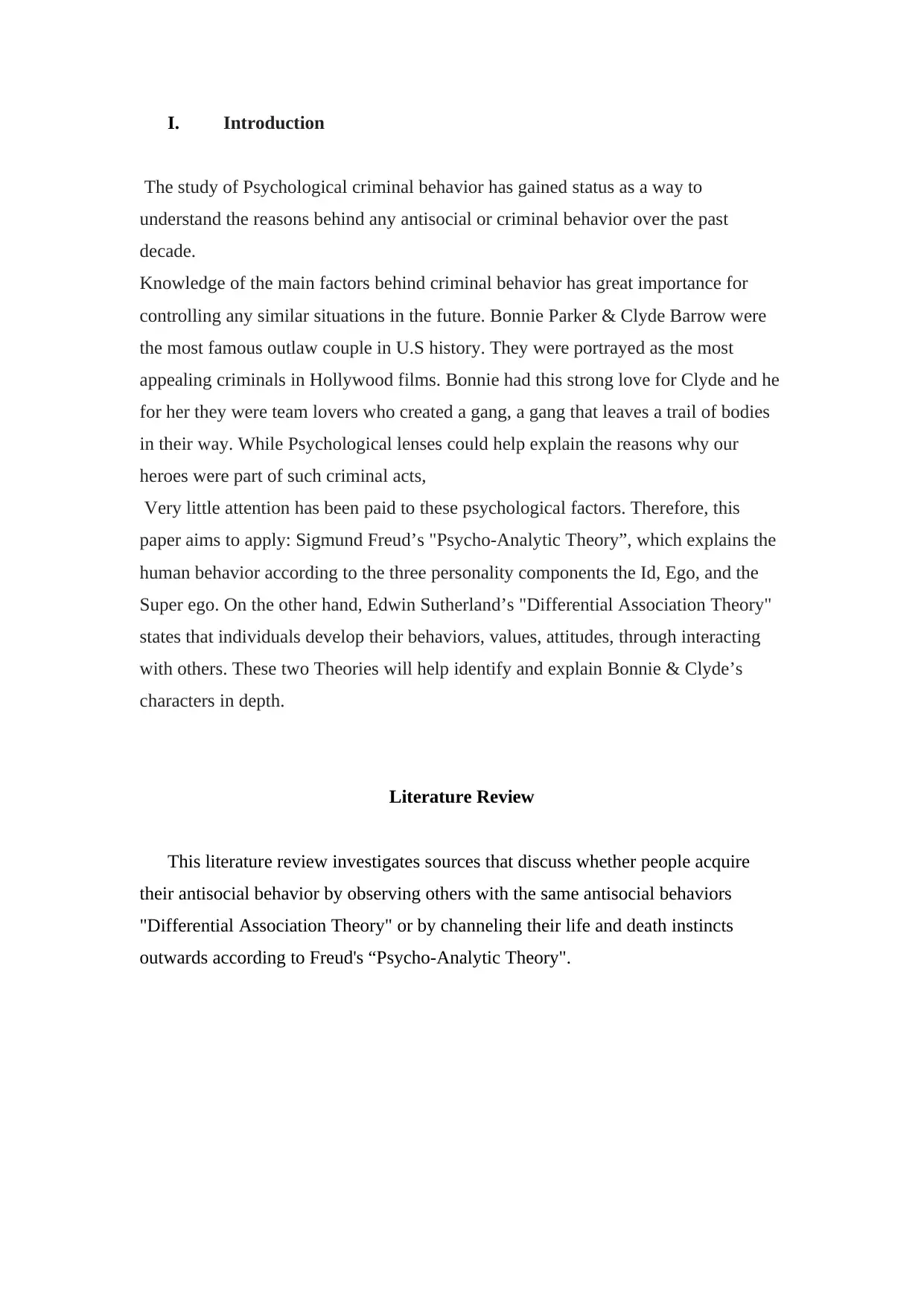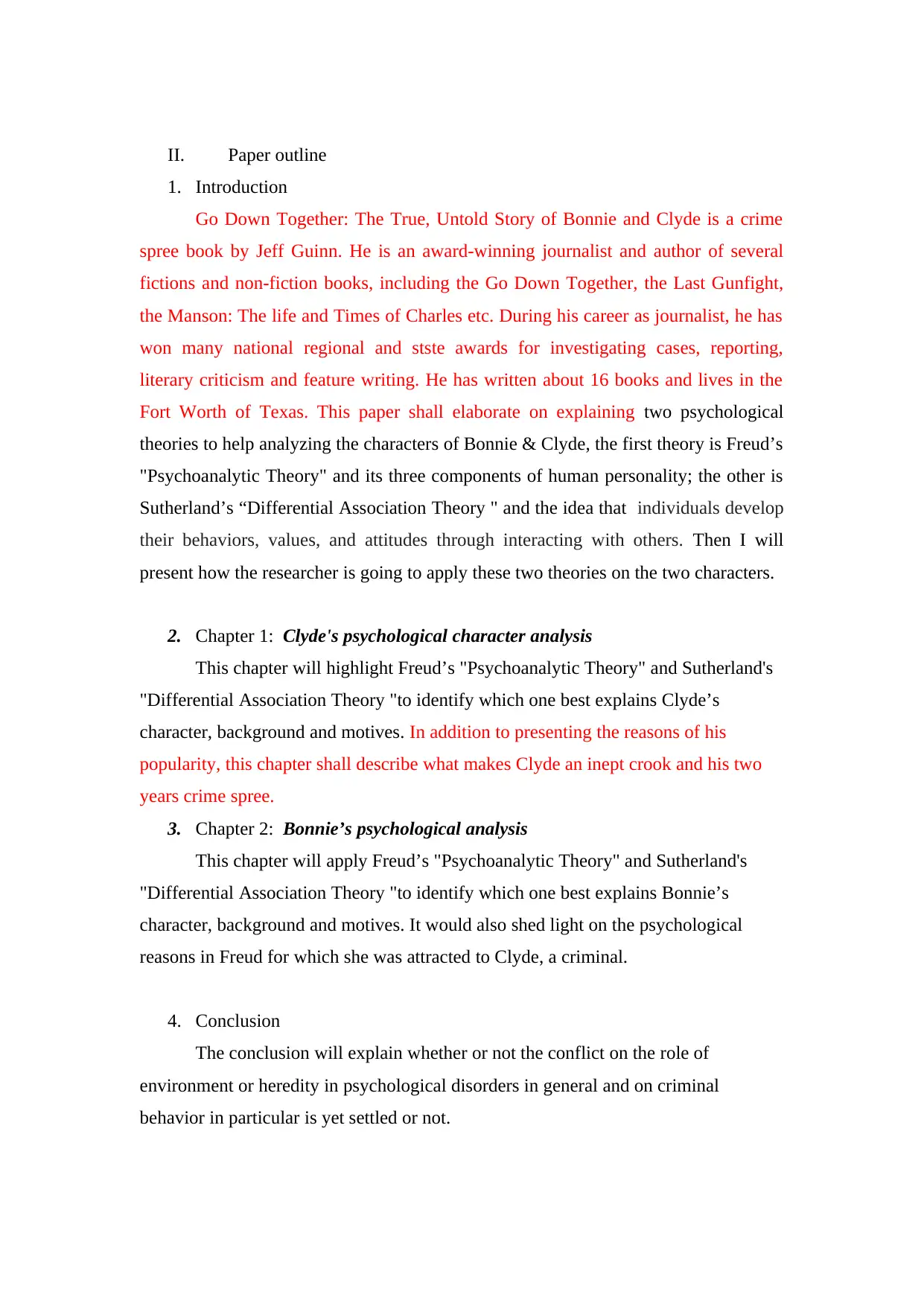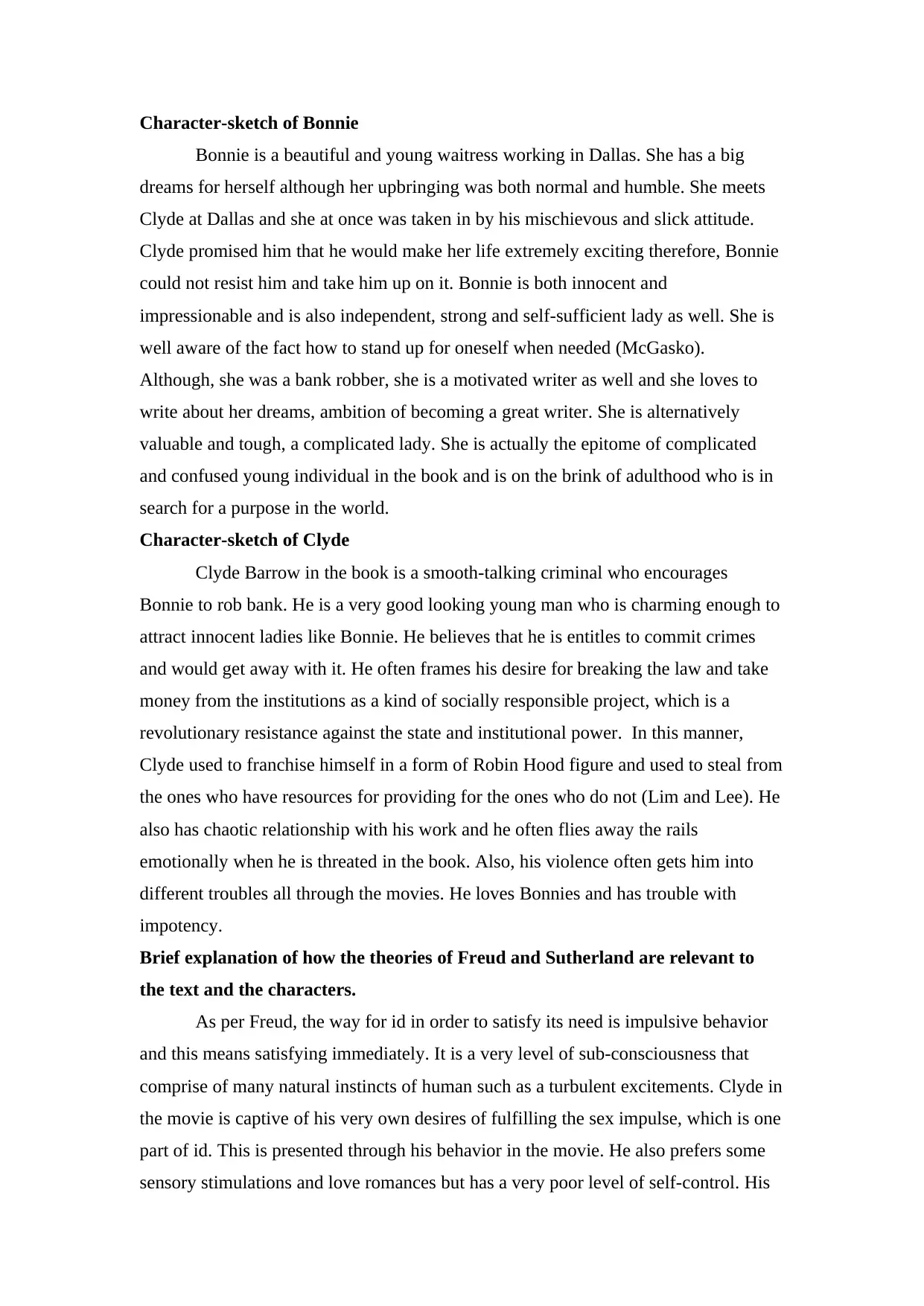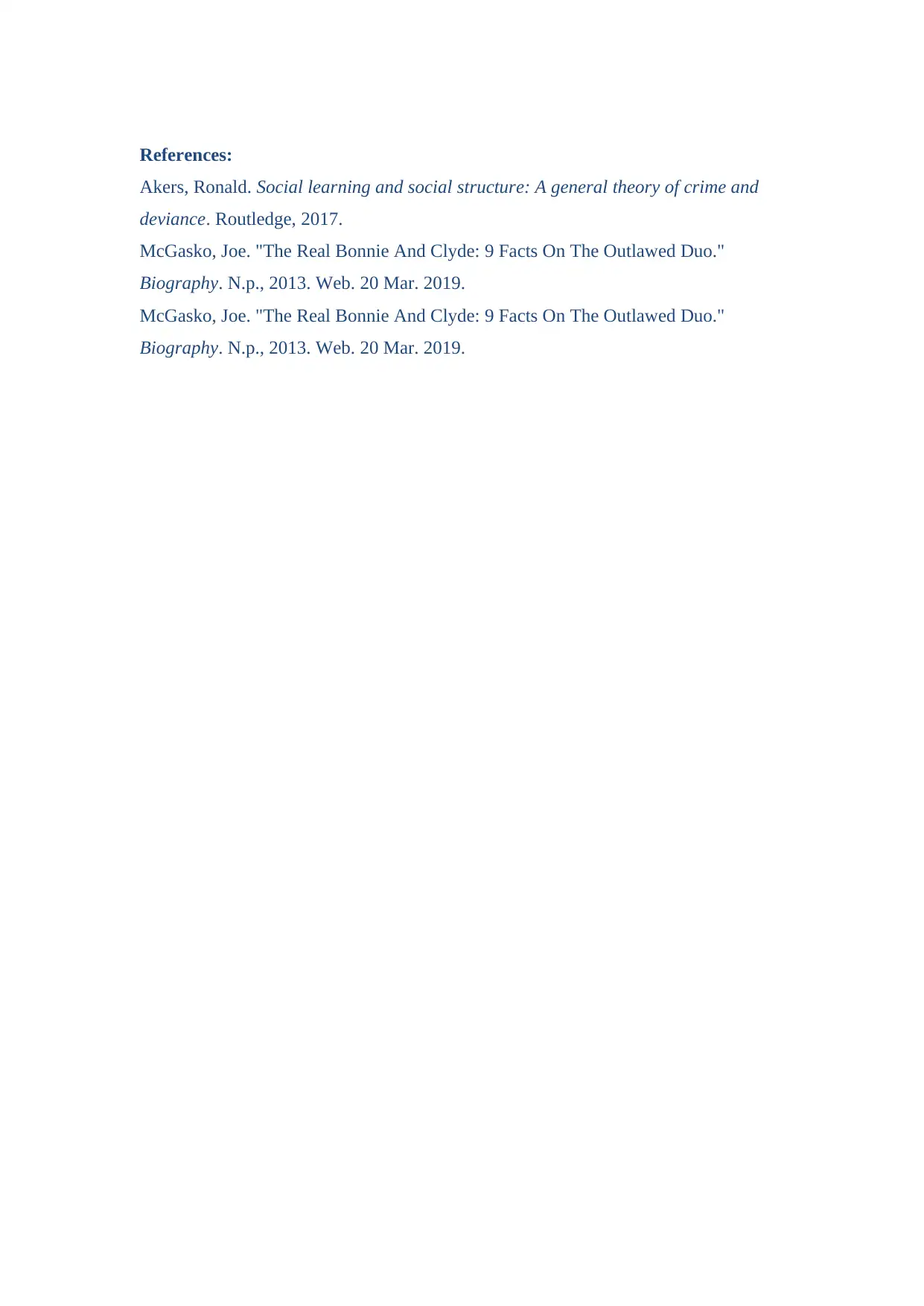Psychoanalytic and Differential Analysis of Bonnie and Clyde
VerifiedAdded on 2023/04/06
|5
|1127
|349
Essay
AI Summary
This essay delves into the psychological aspects of Bonnie and Clyde's criminal behavior, applying Sigmund Freud's Psycho-Analytic Theory and Edwin Sutherland's Differential Association Theory to understand their motivations and actions. It analyzes Bonnie and Clyde's characters, backgrounds, and motives, using Jeff Guinn's book 'Go Down Together' as a primary source. The essay explores Clyde's impulsiveness and lack of self-control through the lens of Freud's id, ego, and superego, while also examining how Bonnie's values and behaviors were influenced by her interactions with Clyde, as explained by Sutherland's theory. The analysis concludes by discussing the ongoing debate about the roles of environment and heredity in psychological disorders and criminal behavior, providing a comprehensive psychological profile of the infamous duo.

I. Introduction
The study of Psychological criminal behavior has gained status as a way to
understand the reasons behind any antisocial or criminal behavior over the past
decade.
Knowledge of the main factors behind criminal behavior has great importance for
controlling any similar situations in the future. Bonnie Parker & Clyde Barrow were
the most famous outlaw couple in U.S history. They were portrayed as the most
appealing criminals in Hollywood films. Bonnie had this strong love for Clyde and he
for her they were team lovers who created a gang, a gang that leaves a trail of bodies
in their way. While Psychological lenses could help explain the reasons why our
heroes were part of such criminal acts,
Very little attention has been paid to these psychological factors. Therefore, this
paper aims to apply: Sigmund Freud’s "Psycho-Analytic Theory”, which explains the
human behavior according to the three personality components the Id, Ego, and the
Super ego. On the other hand, Edwin Sutherland’s "Differential Association Theory"
states that individuals develop their behaviors, values, attitudes, through interacting
with others. These two Theories will help identify and explain Bonnie & Clyde’s
characters in depth.
Literature Review
This literature review investigates sources that discuss whether people acquire
their antisocial behavior by observing others with the same antisocial behaviors
"Differential Association Theory" or by channeling their life and death instincts
outwards according to Freud's “Psycho-Analytic Theory".
The study of Psychological criminal behavior has gained status as a way to
understand the reasons behind any antisocial or criminal behavior over the past
decade.
Knowledge of the main factors behind criminal behavior has great importance for
controlling any similar situations in the future. Bonnie Parker & Clyde Barrow were
the most famous outlaw couple in U.S history. They were portrayed as the most
appealing criminals in Hollywood films. Bonnie had this strong love for Clyde and he
for her they were team lovers who created a gang, a gang that leaves a trail of bodies
in their way. While Psychological lenses could help explain the reasons why our
heroes were part of such criminal acts,
Very little attention has been paid to these psychological factors. Therefore, this
paper aims to apply: Sigmund Freud’s "Psycho-Analytic Theory”, which explains the
human behavior according to the three personality components the Id, Ego, and the
Super ego. On the other hand, Edwin Sutherland’s "Differential Association Theory"
states that individuals develop their behaviors, values, attitudes, through interacting
with others. These two Theories will help identify and explain Bonnie & Clyde’s
characters in depth.
Literature Review
This literature review investigates sources that discuss whether people acquire
their antisocial behavior by observing others with the same antisocial behaviors
"Differential Association Theory" or by channeling their life and death instincts
outwards according to Freud's “Psycho-Analytic Theory".
Paraphrase This Document
Need a fresh take? Get an instant paraphrase of this document with our AI Paraphraser

II. Paper outline
1. Introduction
Go Down Together: The True, Untold Story of Bonnie and Clyde is a crime
spree book by Jeff Guinn. He is an award-winning journalist and author of several
fictions and non-fiction books, including the Go Down Together, the Last Gunfight,
the Manson: The life and Times of Charles etc. During his career as journalist, he has
won many national regional and stste awards for investigating cases, reporting,
literary criticism and feature writing. He has written about 16 books and lives in the
Fort Worth of Texas. This paper shall elaborate on explaining two psychological
theories to help analyzing the characters of Bonnie & Clyde, the first theory is Freud’s
"Psychoanalytic Theory" and its three components of human personality; the other is
Sutherland’s “Differential Association Theory " and the idea that individuals develop
their behaviors, values, and attitudes through interacting with others. Then I will
present how the researcher is going to apply these two theories on the two characters.
2. Chapter 1: Clyde's psychological character analysis
This chapter will highlight Freud’s "Psychoanalytic Theory" and Sutherland's
"Differential Association Theory "to identify which one best explains Clyde’s
character, background and motives. In addition to presenting the reasons of his
popularity, this chapter shall describe what makes Clyde an inept crook and his two
years crime spree.
3. Chapter 2: Bonnie’s psychological analysis
This chapter will apply Freud’s "Psychoanalytic Theory" and Sutherland's
"Differential Association Theory "to identify which one best explains Bonnie’s
character, background and motives. It would also shed light on the psychological
reasons in Freud for which she was attracted to Clyde, a criminal.
4. Conclusion
The conclusion will explain whether or not the conflict on the role of
environment or heredity in psychological disorders in general and on criminal
behavior in particular is yet settled or not.
1. Introduction
Go Down Together: The True, Untold Story of Bonnie and Clyde is a crime
spree book by Jeff Guinn. He is an award-winning journalist and author of several
fictions and non-fiction books, including the Go Down Together, the Last Gunfight,
the Manson: The life and Times of Charles etc. During his career as journalist, he has
won many national regional and stste awards for investigating cases, reporting,
literary criticism and feature writing. He has written about 16 books and lives in the
Fort Worth of Texas. This paper shall elaborate on explaining two psychological
theories to help analyzing the characters of Bonnie & Clyde, the first theory is Freud’s
"Psychoanalytic Theory" and its three components of human personality; the other is
Sutherland’s “Differential Association Theory " and the idea that individuals develop
their behaviors, values, and attitudes through interacting with others. Then I will
present how the researcher is going to apply these two theories on the two characters.
2. Chapter 1: Clyde's psychological character analysis
This chapter will highlight Freud’s "Psychoanalytic Theory" and Sutherland's
"Differential Association Theory "to identify which one best explains Clyde’s
character, background and motives. In addition to presenting the reasons of his
popularity, this chapter shall describe what makes Clyde an inept crook and his two
years crime spree.
3. Chapter 2: Bonnie’s psychological analysis
This chapter will apply Freud’s "Psychoanalytic Theory" and Sutherland's
"Differential Association Theory "to identify which one best explains Bonnie’s
character, background and motives. It would also shed light on the psychological
reasons in Freud for which she was attracted to Clyde, a criminal.
4. Conclusion
The conclusion will explain whether or not the conflict on the role of
environment or heredity in psychological disorders in general and on criminal
behavior in particular is yet settled or not.

Character-sketch of Bonnie
Bonnie is a beautiful and young waitress working in Dallas. She has a big
dreams for herself although her upbringing was both normal and humble. She meets
Clyde at Dallas and she at once was taken in by his mischievous and slick attitude.
Clyde promised him that he would make her life extremely exciting therefore, Bonnie
could not resist him and take him up on it. Bonnie is both innocent and
impressionable and is also independent, strong and self-sufficient lady as well. She is
well aware of the fact how to stand up for oneself when needed (McGasko).
Although, she was a bank robber, she is a motivated writer as well and she loves to
write about her dreams, ambition of becoming a great writer. She is alternatively
valuable and tough, a complicated lady. She is actually the epitome of complicated
and confused young individual in the book and is on the brink of adulthood who is in
search for a purpose in the world.
Character-sketch of Clyde
Clyde Barrow in the book is a smooth-talking criminal who encourages
Bonnie to rob bank. He is a very good looking young man who is charming enough to
attract innocent ladies like Bonnie. He believes that he is entitles to commit crimes
and would get away with it. He often frames his desire for breaking the law and take
money from the institutions as a kind of socially responsible project, which is a
revolutionary resistance against the state and institutional power. In this manner,
Clyde used to franchise himself in a form of Robin Hood figure and used to steal from
the ones who have resources for providing for the ones who do not (Lim and Lee). He
also has chaotic relationship with his work and he often flies away the rails
emotionally when he is threated in the book. Also, his violence often gets him into
different troubles all through the movies. He loves Bonnies and has trouble with
impotency.
Brief explanation of how the theories of Freud and Sutherland are relevant to
the text and the characters.
As per Freud, the way for id in order to satisfy its need is impulsive behavior
and this means satisfying immediately. It is a very level of sub-consciousness that
comprise of many natural instincts of human such as a turbulent excitements. Clyde in
the movie is captive of his very own desires of fulfilling the sex impulse, which is one
part of id. This is presented through his behavior in the movie. He also prefers some
sensory stimulations and love romances but has a very poor level of self-control. His
Bonnie is a beautiful and young waitress working in Dallas. She has a big
dreams for herself although her upbringing was both normal and humble. She meets
Clyde at Dallas and she at once was taken in by his mischievous and slick attitude.
Clyde promised him that he would make her life extremely exciting therefore, Bonnie
could not resist him and take him up on it. Bonnie is both innocent and
impressionable and is also independent, strong and self-sufficient lady as well. She is
well aware of the fact how to stand up for oneself when needed (McGasko).
Although, she was a bank robber, she is a motivated writer as well and she loves to
write about her dreams, ambition of becoming a great writer. She is alternatively
valuable and tough, a complicated lady. She is actually the epitome of complicated
and confused young individual in the book and is on the brink of adulthood who is in
search for a purpose in the world.
Character-sketch of Clyde
Clyde Barrow in the book is a smooth-talking criminal who encourages
Bonnie to rob bank. He is a very good looking young man who is charming enough to
attract innocent ladies like Bonnie. He believes that he is entitles to commit crimes
and would get away with it. He often frames his desire for breaking the law and take
money from the institutions as a kind of socially responsible project, which is a
revolutionary resistance against the state and institutional power. In this manner,
Clyde used to franchise himself in a form of Robin Hood figure and used to steal from
the ones who have resources for providing for the ones who do not (Lim and Lee). He
also has chaotic relationship with his work and he often flies away the rails
emotionally when he is threated in the book. Also, his violence often gets him into
different troubles all through the movies. He loves Bonnies and has trouble with
impotency.
Brief explanation of how the theories of Freud and Sutherland are relevant to
the text and the characters.
As per Freud, the way for id in order to satisfy its need is impulsive behavior
and this means satisfying immediately. It is a very level of sub-consciousness that
comprise of many natural instincts of human such as a turbulent excitements. Clyde in
the movie is captive of his very own desires of fulfilling the sex impulse, which is one
part of id. This is presented through his behavior in the movie. He also prefers some
sensory stimulations and love romances but has a very poor level of self-control. His
⊘ This is a preview!⊘
Do you want full access?
Subscribe today to unlock all pages.

Trusted by 1+ million students worldwide

id gains the upper hand of the structure of personality therefore it is very hard for him
to resist the desire of his sensory stimulation. Moreover, Edwin Sutherland has
claimed that individuals learns by means of interacting with others (Akers). Their
beliefs, values, techniques, motives for the criminal behavior are influenced by others.
In the book, Bonnie, a beautiful small girl and a simple and innocent waitress in
Dallad, is the individual whose beliefs, values, techniques, motives for the criminal
behavior are influenced by Frued and she was easily triggered to get indulge in bank
robbery.
to resist the desire of his sensory stimulation. Moreover, Edwin Sutherland has
claimed that individuals learns by means of interacting with others (Akers). Their
beliefs, values, techniques, motives for the criminal behavior are influenced by others.
In the book, Bonnie, a beautiful small girl and a simple and innocent waitress in
Dallad, is the individual whose beliefs, values, techniques, motives for the criminal
behavior are influenced by Frued and she was easily triggered to get indulge in bank
robbery.
Paraphrase This Document
Need a fresh take? Get an instant paraphrase of this document with our AI Paraphraser

References:
Akers, Ronald. Social learning and social structure: A general theory of crime and
deviance. Routledge, 2017.
McGasko, Joe. "The Real Bonnie And Clyde: 9 Facts On The Outlawed Duo."
Biography. N.p., 2013. Web. 20 Mar. 2019.
McGasko, Joe. "The Real Bonnie And Clyde: 9 Facts On The Outlawed Duo."
Biography. N.p., 2013. Web. 20 Mar. 2019.
Akers, Ronald. Social learning and social structure: A general theory of crime and
deviance. Routledge, 2017.
McGasko, Joe. "The Real Bonnie And Clyde: 9 Facts On The Outlawed Duo."
Biography. N.p., 2013. Web. 20 Mar. 2019.
McGasko, Joe. "The Real Bonnie And Clyde: 9 Facts On The Outlawed Duo."
Biography. N.p., 2013. Web. 20 Mar. 2019.
1 out of 5
Your All-in-One AI-Powered Toolkit for Academic Success.
+13062052269
info@desklib.com
Available 24*7 on WhatsApp / Email
![[object Object]](/_next/static/media/star-bottom.7253800d.svg)
Unlock your academic potential
Copyright © 2020–2025 A2Z Services. All Rights Reserved. Developed and managed by ZUCOL.

